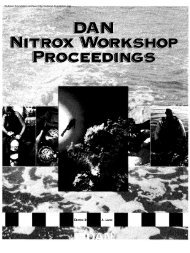Report on Decompression Illness, Diving Fatalities and Project Dive
Report on Decompression Illness, Diving Fatalities and Project Dive
Report on Decompression Illness, Diving Fatalities and Project Dive
- No tags were found...
You also want an ePaper? Increase the reach of your titles
YUMPU automatically turns print PDFs into web optimized ePapers that Google loves.
Secti<strong>on</strong> 2 - <strong>Project</strong> <strong>Dive</strong> Explorati<strong>on</strong> (PDE)Figure 2.3-4Percentageof PDE diversreporting thefollowing acutehealth problemsbefore a dive.2.4 <strong>Dive</strong>sMost PDE data (98 percent) were collected during recreati<strong>on</strong>al divingin an ocean (saltwater) envir<strong>on</strong>ment; 1.3 percent of PDE diveprofiles came from freshwater diving. Only 72 dives were recordedin caves or caverns, <strong>and</strong> 12 dives were d<strong>on</strong>e in Antarctica.Figure 2.4-1Percentageof the PDEsample by diveplatform(n=26,767).Figure 2.4-1 shows the dive platform from which the PDE divestook place. The majority of PDE dive profiles were collected fromliveaboards (57 percent). This subgroup represents a valuabledataset of repetitive <strong>and</strong> multiday diving exposures. Thirty-fourpercent of dives were collected <strong>on</strong> charter boats that take diversfor <strong>on</strong>e day or half-day trips. Only 3 percent of the PDE diveswere walk-in beach dives, <strong>and</strong> 4 percent were dives from smallprivate boats.30DAN’s <str<strong>on</strong>g>Report</str<strong>on</strong>g> <strong>on</strong> Decompressi<strong>on</strong> <strong>Illness</strong>, <strong>Diving</strong> <strong>Fatalities</strong> <strong>and</strong> <strong>Project</strong> <strong>Dive</strong> Explorati<strong>on</strong>: 2005 Editi<strong>on</strong>
















